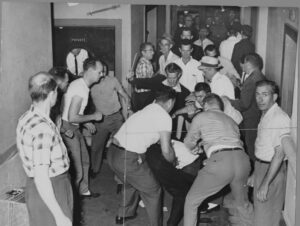Throughout much of history, focusing specifically on American history, black women have been the subject of fetishization, hypersexualization, and objectification in many forms that more often than not leads to various forms of violence. In “Betsy’s Borrowed Baby” we saw direct examples of this experience through Betsy’s assault on the train by the white man who entered the Jim Crow car when no one else was there. Betsy was doing nothing other than making a trip home just like the thousands of other college students at that time of year. However, she was a black woman who happened to be caught in a situation that made her extra physically vulnerable to attack, and a white man saw it as an opportunity to attack her as an object of his fetishization.
During the attack, the assailant says, “Some of them who have the fear of God in their heart, when they see a white man, aint so sassy as you are, though,” (Terrell Betsy’s Borrowed Baby 48) making it clear he has done this many times before and is very clear of his standing as a white man attacking black female college students on their way home. As well, he calls Betsy “sassy” for resisting his attack, noting his fetishization of her directly. Later when she continues to resist, he threatens to, “…throw you off the train and break your sassy neck,”(Terrell Betsy’s Borrowed Baby 48). Here, the assailant threatens her with murder if she does not comply, a fate that awaits far too many black women. As well, there is no guarantee he wouldn’t have killed her regardless if she complied with him or not, since clearly part of the assailant’s pleasure was in the violence he subjected his victims to.
(FX’s “Pose” Season 2 Ep 4)
Unfortunately, this violence stemming from fetishization, hypersexualization, and objectification is not a thing of the past that disappeared with slavery or the Jim Crow Era. It is very much alive and well in various ways. One of the most prevalent modern forms of these issues is apparent in the black trans and queer communities, most commonly among black trans sex workers. Documentaries such as “Paris is Burning” and historical fiction works such as “Pose” do an excellent job of demonstrating the lives of people in these communities, and all too often the loss at the hands of violence from them. As discussed in class, many people (most often but not exclusively married white men) still hold the societal standard that they must “act as gentlemen” in their family and marital lives. In the past slave owners would try to uphold the idea of their wives as “ideal” women and brutalize their slaves. Moreover, in the era of Jim Crow, these men would take advantage of the injustices of the law and society for the same purposes. However, in modern society without slaves or Jim Crow laws, many men revert to the treatment of sex workers, often black trans women, to enact their most brutal desires of violence, and project their objectification, fetishization, and hypersexualization of black people.



